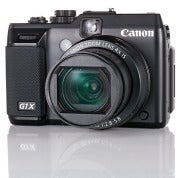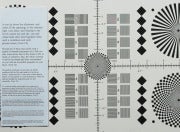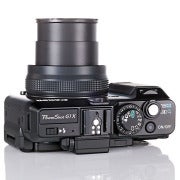If you want the highest photo quality, turn to the 14-megapixel Canon PowerShot G1 X, which in our tests produced the best images we've ever seen from a fixed-lens camera. Even in challenging lighting conditions, it delivers photos that transcend the output from much of the point-and-shoot competition.
 At $800 (as of August 6, 2012), the PowerShot G1 X is extremely expensive for a fixed-lens camera, with a price, feature set, and body more in line with an entry-level DSLR body or an interchangeable-lens mirrorless camera. The G1 X's almost-APS-C-size sensor, manual exposure controls, built-in ND filter, RAW capture mode, and compatibility with Canon's external Speedlite flashes are all standout features. Beyond its jaw-dropping image quality, however, this camera has a few more red flags than any other model in its class. In many ways it's the best fixed-lens camera I've ever used: Its image quality is second to none, its manual controls are well laid out and easy to access, it has a tilt-and-swivel LCD screen to help with odd-angle shots, and its automated shooting modes are useful and perform well. In other important respects, it's a major letdown: Its minimum focus distance is more than half a foot away from the subject, its autofocus system is slow and buggy compared with those of other premium compacts, it has trouble freezing fast action in its continuous-shooting mode, and its manual focus controls feel like an afterthought—a strange shortcoming for such a manual-oriented camera. The sum of all those parts is still a great option for experienced photographers or for DSLR owners who want a secondary camera. Whether it's right for you, however, depends a lot on how you plan to use it. For landscapes, portraits, and static subjects, it's a great performer. For macro photography and action photos, it's bound to frustrate you. Novice photographers may want to steer clear unless they're willing to undergo PowerShot G1 X boot camp. As long as you're a few feet away from a stationary subject, you'll be able to take amazing photos in Auto mode; for the price and for the usability hiccups, though, you might as well buy a DSLR or a mirrorless model.
At $800 (as of August 6, 2012), the PowerShot G1 X is extremely expensive for a fixed-lens camera, with a price, feature set, and body more in line with an entry-level DSLR body or an interchangeable-lens mirrorless camera. The G1 X's almost-APS-C-size sensor, manual exposure controls, built-in ND filter, RAW capture mode, and compatibility with Canon's external Speedlite flashes are all standout features. Beyond its jaw-dropping image quality, however, this camera has a few more red flags than any other model in its class. In many ways it's the best fixed-lens camera I've ever used: Its image quality is second to none, its manual controls are well laid out and easy to access, it has a tilt-and-swivel LCD screen to help with odd-angle shots, and its automated shooting modes are useful and perform well. In other important respects, it's a major letdown: Its minimum focus distance is more than half a foot away from the subject, its autofocus system is slow and buggy compared with those of other premium compacts, it has trouble freezing fast action in its continuous-shooting mode, and its manual focus controls feel like an afterthought—a strange shortcoming for such a manual-oriented camera. The sum of all those parts is still a great option for experienced photographers or for DSLR owners who want a secondary camera. Whether it's right for you, however, depends a lot on how you plan to use it. For landscapes, portraits, and static subjects, it's a great performer. For macro photography and action photos, it's bound to frustrate you. Novice photographers may want to steer clear unless they're willing to undergo PowerShot G1 X boot camp. As long as you're a few feet away from a stationary subject, you'll be able to take amazing photos in Auto mode; for the price and for the usability hiccups, though, you might as well buy a DSLR or a mirrorless model.Performance, Image Quality, and Video Quality
In addition to its extensive manual controls, the Canon PowerShot G1 X has one of the best Auto modes we've seen in a camera. In fact, the camera is slated for induction into the PCWorld Labs hall of fame, as it recorded the first Perfect score we've seen in the category of image sharpness.
In the shots we took for the PCWorld Labs' subjective tests of image quality, the G1 X's images showcased sharp lines and excellent contrast without any evidence of fringing or chromatic aberration. The PowerShot G1 X is no slouch in other areas, either, as it turned in very impressive scores for exposure quality (Superior), color accuracy (Very Good), and lack of distortion (Superior). In image quality, it's probably the best point-and-shoot camera we've ever tested, period.
You can see its excellent output for yourself. To view the full-size photos we used in our subjective tests, click the thumbnail images to the left.
The Canon PowerShot G1 X produces excellent video quality, as well. The camera shoots 1080p video at 24 frames per second (the setting we used for our tests), as well as 720p or 640-by-480-pixel footage at 30 fps. You can use different white balance settings and a few creative effects in video mode, but you won't get the manual exposure or frame-rate controls for video that you'll find in two of this model's premium competitors, the Panasonic Lumix DMC-LX7 and the Sony Cyber-shot DSC-RX100.
The G1 X's test footage impressed our judges, as the camera earned a score of Superior for overall video quality. Video footage we shot with the camera in a well-lit setting looked very sharp, with excellent color fidelity, smooth motion, and fine detail. In our low-light tests, footage looked predictably dark, but had less visual noise and problematic motion handling than the video we've seen from other cameras. Audio pickup through the camera's top-mounted stereo microphones was decent; the sound quality earned a score of Good in our tests. Unfortunately, the camera has no mic-in jack for an external microphone.
You can watch the low-light test clip we used for the PCWorld Labs' subjective evaluations below. Select 1080p from the bottom menu in the player for the full-resolution clip.
The PowerShot G1 X is one of a only a few fixed-lens cameras available these days with an eye-level optical viewfinder. The optical viewfinder has some major drawbacks (more on that in the "Hardware and Design" section below), but it will help you squeeze a lot more juice out of its battery if you opt to turn the LCD off. With its LCD on, the PowerShot G1 X is rated for 250 shots per charge of its battery, which puts it in the Good range of our battery-life scores. With the LCD off, the camera is rated at an excellent 700 shots per charge.
Hardware and Design
This thing is built like a tank. It feels as sturdy as any camera I've held, and its sheer size is more like that of a smaller DSLR body (without a lens attached) or a mirrorless interchangeable-lens camera. It's nowhere near pocketable, but Canon has used the camera's extra real estate well.
Thanks to the PowerShot G1 X's larger size, the camera has ample room for a comfortable hand grip, sturdy dials and buttons that give you quick access to everything from exposure-compensation adjustments to video recording, a tilt-and-swivel LCD screen, a pop-up flash, and a hot shoe. The circumference of the lens is quite a bit larger than what you'll find on other premium compact cameras, and a removable cap protects the lens.
The G1 X is the first G-series model with a CMOS sensor—and that sensor is the shining star of this camera. The camera's 14-megapixel 1.5-inch-type sensor dwarfs the 1/1.7-inch-type imagers found in most cameras in the premium point-and-shoot class. In the real world, that translates to the excellent image quality we found in our tests, as well as to very good low-light performance for a camera that isn't a DSLR.
The lens's maximum aperture values range from F2.8 on the wide-angle end to F5.8 telephoto, and the camera's shutter speeds range from 1/4000 of a second to a full minute. Despite the camera's relatively narrow F2.8 aperture of 28mm, it still achieves shallow depth-of-field effects when you're shooting subjects at close range.
In addition, the camera's sensor size contributes to standout low-light performance for a fixed-lens camera; the G1 X's ISO equivalency settings reach up to a stunning 12,800, although I had much better results in low-light settings when I used the camera's Handheld Night Scene mode. For a fixed-lens camera, its high-ISO performance is still very good, but you shouldn't expect the kind of performance you'd get from a DSLR at the upper reaches.
The camera's 4X-optical-zoom lens covers a range of 28mm wide-angle to 112mm telephoto, and a 4X digital zoom extends that range to a simulated 448mm on the telephoto end. I should note that at its widest-angle focal length, the lens extends from the camera quite a bit more than the lens of any other fixed-lens camera I've used; this design comes into play when you're using the optical viewfinder.
The PowerShot G1 X's optical viewfinder definitely doesn't live up to DSLR quality. Obviously, it isn't a through-the-lens optical viewfinder; only a DSLR offers that particular feature. And the G1 X's viewfinder does offer a few nifty tricks, such as a field of view that zooms in and out accordingly as you're adjusting the camera's lens.
Nevertheless, the G1 X's viewfinder has two major flaws. First and foremost, framing a shot is difficult when the lens covers up a sizable portion of your field of view, which is exactly what happens when you look through the eyepiece at wide-angle focal lengths: The lens gets in the way of the bottom-left corner of your view. Second, what you see through the eyepiece is always quite different from what you're actually capturing; the lens has a much wider field of view than the viewfinder does, and it's also positioned significantly lower than the eyepiece, which means the viewfinder isn't even useful for basic shot composition.
Luckily, the camera's 3-inch-diagonal, adjustable LCD screen is excellent. You can turn it off and use the viewfinder to save battery life, but you're going to need the LCD if you want an accurate representation of what you're shooting.
Shooting Modes and Features
Without a doubt, the PowerShot G1 X will appeal more to photographers who know their way around manual exposure controls than those who want just a simple point-and-shoot. The features and controls in the PowerShot G1 X include much of what you'll find in a DSLR (RAW mode, an exposure-lock button, a button to adjust the point of focus, aperture- and shutter-priority modes, manual mode, program auto mode, and two custom presets on the mode dial).
You also get a focus-bracketing mode that lets you snap three successive shots at slightly different focal lengths, as well as an exposure-bracketing mode and a built-in neutral density filter that you can switch on and off via the camera's menus. Dedicated dials make adjusting exposure compensation and shutter/aperture values easy.
Although the G1 X is built primarily for seasoned shooters, it has its fair share of beginner-friendly scene modes and filters. As we noted during the PCWorld Labs' image-quality tests, its Auto mode is phenomenal, as long as you're not trying to take an extreme close-up—the autofocus won't cooperate there.
The main drawbacks of this camera are its macro mode, its hit-or-miss autofocus system, its manual focus controls, and its performance in burst mode.
For starters, you'll need to be at least half a foot away from your subject in order to capture a crisp shot, and even then the camera's autofocus system has a tendency to search in and out. In my tests, even when some subjects were about a foot away, the autofocus system didn't settle on a sharp focus at all. For example, I tried to take shots of a bee sitting on a flower from about a foot and a half away. I never did get the shot, as the autofocus system refused to lock in on the bee, and the bee had flown away by the time I switched to manual focus mode. With that in mind, expect to take a few wider-angle shots and to do some image cropping if you want a very tight close-up of an insect, a flower, or any other common macro subject.
For a high-end camera, the PowerShot G1 X has lackluster manual focus controls, as well. You can't choose manual focus in Auto mode (although you can in Program Auto mode), which means you're stuck with whatever the AF system selects for you. What's more, you have to fine-tune the focus by using the camera's back-mounted scrollwheel, which feels a bit too tacked on for a camera with so many manual controls. For adjusting focus, the G1 X would have benefited greatly from a lens-barrel control ring like the one on the Canon PowerShot S100.
On a positive note, some real gems are hidden in the camera's creative filters and scene mode menus. I can't say enough about the G1 X's Handheld Night Scene mode, which is the best option for capturing crisp, well-exposed shots in the dark without a flash. You'll also find an automatic three-shot HDR mode, a miniature mode that simulates the effects of a tilt-shift lens, and the excellent Color Accent mode, which lets you isolate a single color in a black-and-white shot. Also useful are the G1 X's in-camera panorama stitching scene mode and its 4.5-fps burst mode, although the latter has its problems. Again, autofocus speeds are the issue, as moving objects can still look like a blur.
Also in the mix are a few more-gimmicky settings, such as a fish-eye-lens simulator, a toy-camera mode, and color filters; any photographer skilled enough to be interested in the G1 X would be more likely to add those kinds of effects with an editing tool (or not at all).
In video mode, you can apply the Color Accent and miniature filters (the latter at a maximum frame rate of 6 fps at 720p resolution), but this isn't the quietest camera when zooming in and out. The camera has a built-in wind filter that reduces some ambient noise while filming, but you'll hear the lens motors in your footage if you zoom in and out while recording.
Bottom Line
You simply won't find better all-around image quality from a fixed-lens camera. When you can get the Canon PowerShot G1 X to cooperate, it takes tack-sharp, great-looking photos. Thanks to its physical knobs and buttons, and its larger-than-most body size, it's as close as a camera comes to a DSLR without offering interchangeable lenses.
However, this camera is far from a must-buy, since $800 is a lot to pay for a fixed-lens camera, not to mention one with the G1 X's shortcomings. The camera's macro capabilities, autofocus speeds, continuous-shooting performance, and optical viewfinder are all subpar.
All in all, $800 gets you the best fixed-lens camera for portraits, landscapes, and sharp shots at night if you use its Handheld Night Scene mode. Nothing's perfect, of course, but if Canon fixes the macro mode and the continuous-shooting performance in the PowerShot G1 X's successor, it will come pretty darn close.












No comments:
Post a Comment